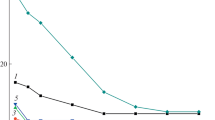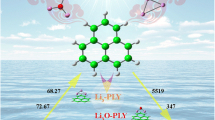Abstract
Electronic state and optical absorption spectra of metal alkoxides stabilized with β-diketones (with a variety of substituents) were calculated using first-principle molecular orbital methods. The characteristics of the optical absorption and the mechanism of the photodissociation of alkoxides with irradiation of light are discussed. The position of the first peak observed in the near UV region in the theoretical spectra corresponded to that observed in the experimental spectra with a 25 nm shift toward shorter wavelengths. The first absorption peak observed in the visible range originated from electronic transitions to molecular orbitals, including the antibonding components of the C–O bonding in the chelate ring. The results suggested that the bonding of the chelate rings should be important in controlling the photosensitivity of chemically modified titanium alkoxides.
Similar content being viewed by others
Avoid common mistakes on your manuscript.
1 Introduction
Micro patterning processes of oxide thin films are very attractive for their applications in micro capacitors, diffraction gratings etc. The sol–gel method is one of the most applicable methods for the micro patterning of oxide thin films [1, 2]. We have already reported that gel films derived from chemically modified alkoxides exhibit photo reactivity, and micro patterning of the films can be achieved using photo irradiation in conjunction with appropriate masks [3–10]. In this method, we can control the solubility of the gel films, since the photo irradiated regions exhibit lower solubility in organic solvent such as alcohol, hexane, acetone, etc.
The solubility of the gel films is controlled by the photochemically-induced reactions of chelates (such as β-diketones) bound to the metal centres, with the positions of absorption peaks being modulated by the properties of the chelates. Control of the wavelengths of absorption is very important, since matching of the wavelength of absorption and irradiation is necessary to promote efficient reaction. The electronic properties of the chelate, and the corresponding absorption spectra, can be tuned by controlling the length of resonance structures within the chelates. Thus, understanding the electronic properties of the chelate is desirable to understand its optical absorption spectra and the optical chemical reactivity of the gel films.
In the present study we have calculated the electronic states of chemically modified titanium alkoxides. The absorption spectra and the optical chemical reactivity of gel films derived from these precursors are discussed.
2 Calculation method
In the present study, we have applied two distinct first-principle molecular orbital calculation methods. The first of these is the Hartree-Fock method, STO-3G, in PC Spartan® for structural optimization of the model clusters. Then, the DV-Xα cluster method was used to obtain the bonding nature and the absorption spectra of the chemically modified alkoxides. This latter method is a linear combination of atomic orbital (LCAO) molecular orbital method, in which the exchange potential, V XC, is described by:
where ρ is the electron density of the cluster and α is a constant [11]. α was fixed at 0.7 in the present work. The Mulliken population analysis was used for the bonding state between atoms. We have used Slater’s transition state calculation method, which gave quite accurate results reflecting the relaxation effects of molecular orbitals caused by electronic transitions [12], to obtain the UV–Vis absorption spectra. Since several molecular orbitals in the model clusters are involved in the absorption spectra, the spectra were obtained by the summation of the absorptions for all combinations of the electronics transitions between the molecular orbitals within 4 eV of the energy difference.
We have used several model clusters derived from Ti(O-sec-Bu)4 with several different stabilizing reagents. Figure 1 illustrates the structure of Ti(O-sec-Bu)4 modified by 1-phenyl-1,3-butanedione, which is an example of one of the model clusters used. Thirteen distinct chelating reagents were used for the model clusters:
-
acetylacetone;
-
3-methyl-1,3-pentanedione;
-
3-ethyl-1,3-pentanedione;
-
1-(5-bromo-2-hydroxyphenyl)-phenyl-1,3-propanedione;
-
1,3-diphenyl-1,3-propanedione;
-
phenyl-1,3-butanedione;
-
1-(2-hydroxyphenyl)-phenyl-1,3-propanedione;
-
1-(5-chloro-2-hydroxyphenyl)-phenyl-1,3-propanedione;
-
1,1,1-trifluoro-2,4-pentanedione;
-
1,1,1-trifluoro-5,5-dimethyl-2,4-hexanedione;
-
1-(2-phenyl)-4,4,4-trifluoro-1,3-butanedione;
-
1′-hydroxy-2′-acetonaphthone;
-
hydroxyacetophenone.
Several reports have discussed the structure of Ti(IV) alkoxides stabilized with chelates [13]. In these studies, the coordination number of the Ti(IV) was found to be six in the gel films derived from the Ti alkoxides modified by several kinds of stabilizing reagents. However, it is common to use the simplest model to analyze fundamental electronic states, since no studies have described the structure of chemically modified Ti alkoxides incorporating all of the stabilizing reagents shown here. Furthermore we have used the simplest model clusters to simplify the first-principle calculations, to avoid the considerably longer calculation time required for more complex models.
3 Results and discussion
Figure 2 shows the absorption spectrum of Ti(O-sec-Bu)4 stabilized by 1-phenyl-1,3-butanedione. In the figure the solid line shows the theoretical result and the dotted line shows the experimental spectrum of the gel film. We can obtain the theoretical spectra by the summation of each transition between the molecular orbitals. Generally, we have calculated theoretical spectra at higher resolutions than the experimental ones so that the detail of the experimental spectra can be analyzed. In the theoretical spectrum, there are two major absorption peaks at 320 and 220 nm, which were each composed of several smaller peaks. These peaks appear to correspond to the peaks at 359 and 264 nm in the experimental spectrum. This result indicates that the broad peaks observed in the experimental spectrum each include contributions from several electronic transitions between different combinations of molecular orbitals. The peak positions observed in the theoretical spectrum are shifted about 40 nm towards lower wavelengths compared with those in the experimental spectrum. However, other key features of the theoretical spectrum, such as the relative intensities and relative peak positions, are very similar to those of the experimental spectrum. A detailed analysis of the molecular orbitals contributing to the absorptions shown in Fig. 2 indicates that the majority of observed peaks arise from transitions between molecular orbitals of the chelate ring. There were only very minor contributions of the Ti(IV) atomic orbitals to these molecular orbitals. The result suggests that the Ti(IV) atomic orbitals do not directly affect the absorption spectra, although the atomic potentials could shift the peak positions to lower wavelengths, as observed experimentally.
Figure 3 illustrates the absorption spectra of the cluster involving 1′-hydroxy-2′-acetonaphthone. In the spectrum of the gel film, there are three peaks at 425, 370, and 264 nm. Since the peaks at 425 and 370 nm are very broad, this film exhibits a good response for optical chemical reactions over a very wide visible wavelength range. The theoretical spectrum exhibits in excess of six peak profiles, with each profile composed of several small peaks. The first calculated peak is observed at 383 nm, which is about 40 nm lower than that observed in the experimental spectrum. The second and third peaks in the calculated spectrum appear at 314 and 282 nm. The theoretical results suggest that the broad peak observed in the visible region of the gel films is composed of two major peaks. In contrast, there are four peaks in the UV region of the theoretical spectrum, while only two peaks are observed in the corresponding region of the experimental spectrum. This result suggests that the broad peaks observed in the UV region of the experimental spectrum are composed of several peaks (in particular, a shoulder is clearly evident on the high-wavelength side of the 264-nm peak), due to transitions between different combinations of the molecular orbitals. Thus the theoretical calculation is a useful tool for discussing the absorption spectra of chemically stabilized Ti(IV) alkoxides. In patterning processes exploiting optically-excited chemical reactions, the irradiation wavelength must correspond to the peak position observed in the spectra of the gel films. In the case of the broad peak observed in the gel films derived from Ti(IV) alkoxides chelated by 1′-hydroxy-2′-acetonaphthone, there are only two major peaks in the visible region which could be employed for photopatterning.
Figure 4 shows the relationship between the first peak position observed in the theoretical and measured spectra. The solid line illustrates the results of the least mean square analysis for chelates without fluoroalkyl groups, while the dotted line shows the corresponding result for chelates bearing fluoroalkyl groups. The majority of theoretical peak positions are shifted by about 26 nm toward smaller wavelengths compared with the corresponding measured peak positions. This shift is attributed to the influence of the small model clusters used in the calculations and to neglect of the surrounding environment. The results suggest that the position of the first absorption peak can be estimated from first-principle molecular orbital calculations involving small model clusters. However, it is interesting to note that chelates bearing fluoroalkyl substituents do not exhibit any significant difference between the theoretical and measured peak positions. This observation suggests that the fluorinated chelates interact to a lesser extent with the surrounding environment.
The mechanism of the decomposition reaction of the chemically stabilized Ti(IV) alkoxides under irradiation is also a key factor for optimizing the wavelength of irradiation and controlling the environment during reaction. When the film is irradiated, all absorptions were attributed to the transitions from the molecular orbitals near the HOMO to the LUMO, which includes a large antibonding component arising from the C–O bonding of the chelate ring. This result suggests that the C–O bonding in the chelate ring becomes weaker after absorption. In addition, the LUMO has a wider distribution of molecular orbitals toward the outside of the chelate ring, which leads to an increase in the reactivity of the C–O bond towards surrounding molecules such as H2O, O2, alcohols etc. This reactivity might be the origin of the decomposition reaction of the Ti(IV) alkoxides. However, to further investigate the dissociation mechanism, it will be necessary to investigate photochemical reactions of gel films in environments where such reactive molecules are excluded, such as in vacuum.
4 Conclusion
The electronic states of a series of chemically-modified Ti(IV) alkoxides were calculated from first-principle molecular orbital methods. Thirteen distinct chelating species were used for the model clusters. The structural optimization of the clusters was achieved by the ab initio HF method and the theoretical UV–Vis absorption spectra were obtained by the DV-Xα method. In general, the shapes of the theoretical spectra corresponded to those measured experimentally, except for shifts in the observed peak positions. The average shift observed was about 26 nm toward smaller wavelengths, except for chelates bearing fluoroalkyl substituents. The observed shifts were attributed to interactions between the chelates and the surrounding environment, which were not considered during modeling. The analysis of the chemical bonding suggested that the dissociation reaction of the chemically modified Ti alkoxides is caused by the increase of the antibonding components of the C–O bonding within the chelate ring.
References
Heuberger K, Lukosz W (1986) Appl Opt 25:1449. doi:10.1364/AO.25.001499
Roncone RL, Weller-Brophy LA, Weisenbach L, Zelinski BJJ (1991) J Non-Cryst Solids 128:111. doi:10.1016/0022-3093(91)90502-W
Tohge N, Shinmou K, Minami T (1994) J Sol-Gel Sci Technol 2:581. doi:10.1007/BF00486313
Shinmou K, Tohge N, Minami T (1994) Jpn J Appl Phys 33:L1181. doi:10.1143/JJAP.33.L1181
Tohge N, Shinmou K, Minami T (1994) SPIE Proc. Sol-Gel Opt III 2288:589
Zhao G, Tohge N (1995) J Ceram Soc 103:176
Tohge N, Zhao G (1997) SPIE Proc. Sol-Gel Opt IV 3136:176
Zhao G, Tohge N (1998) Mater Res Bull 33:21. doi:10.1016/S0025-5408(97)00188-8
Zhao G, Tohge N, Nishii J (1998) Jpn J Appl Phys 37:1842. doi:10.1143/JJAP.37.1842
Tohge N, Zhao G, Chiba F (1999) Thin Solid Films 351:85–90. doi:10.1016/S0040-6090(99)00082-6
Adachi H, Tsukada M, Satoko C (1978) J Phys Soc Jpn 45:875. doi:10.1143/JPSJ.45.875
Slater JC (1979) The calculation of molecular orbitals. Wiley, New York
Errington RJ, Ridland J, Clegg W, Coxall RA, Sherwood JM (1998) Polyhedron 17:659. doi:10.1016/S0277-5387(97)00418-X
Author information
Authors and Affiliations
Corresponding author
Rights and permissions
About this article
Cite this article
Kowada, Y., Noma, N. Electronic state and photosensitivity of metal alkoxides chemically modified with β-diketones. J Sol-Gel Sci Technol 52, 166–169 (2009). https://doi.org/10.1007/s10971-009-1994-2
Received:
Accepted:
Published:
Issue Date:
DOI: https://doi.org/10.1007/s10971-009-1994-2








